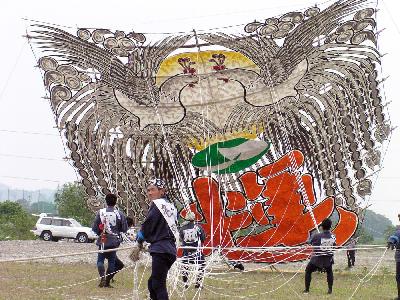|
Many kite-flying activities take place during the Yokaichi Giant Kite Festival. The Yokaichi giant kite is designated as an intangible folk cultural asset.
Yokaichi giant kite-flying started 300 years ago in the mid-Edo period. Kites were flown to celebrate the birth of a boy. For this reason, kite-flying is similar to the display of koinobori on Boy's Day, an important event in Japan. Nowadays, over 100 kites are flown, and they are even flown to celebrate a young person's coming of age.
Yokaichi giant kites are designed with 'hanjimon otako', which features pictures of fishes and birds in the upper section with words written in red to illustrate meanings. This kite, in a sense, is rare because it has cut-out sections that help to diminish resistance from wind. Flying these giant kites involves balancing the strength of the strings with the size of the kite.
The Yokaichi Giant Kite Festival is held annually on the 4th Sunday of May in Aichi-gawa.
Yokaichi giant kite-flying started 300 years ago in the mid-Edo period. Kites were flown to celebrate the birth of a boy. For this reason, kite-flying is similar to the display of koinobori on Boy's Day, an important event in Japan. Nowadays, over 100 kites are flown, and they are even flown to celebrate a young person's coming of age.
Yokaichi giant kites are designed with 'hanjimon otako', which features pictures of fishes and birds in the upper section with words written in red to illustrate meanings. This kite, in a sense, is rare because it has cut-out sections that help to diminish resistance from wind. Flying these giant kites involves balancing the strength of the strings with the size of the kite.
The Yokaichi Giant Kite Festival is held annually on the 4th Sunday of May in Aichi-gawa.
| [+ADDRESS] | 
|













